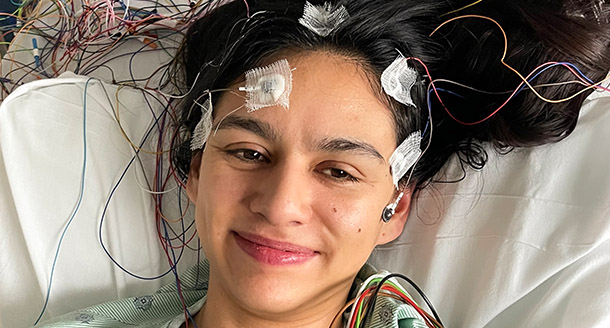NBTS contributed to the funding of this research study through a grant awarded to Dr. Mariano Viapiano.
Tumor-treating fields plus chemotherapy versus chemotherapy alone for glioblastoma at first recurrence: a post hoc analysis of the EF-14 trial: Kesari, S, Ram, Z; on behalf of EF-14 Trial Investigators (2017) CNS Oncology. DOI:10.2217/cns-2016-0049
> View the paper
Tumor-treating fields (TTFields), delivers low-intensity, intermediate-frequency (200 kHz) alternating electric fields via transducer arrays applied to the shaved scalp and is a treatment that was recently approved by the US FDA for use in combination with temozolomide (TMZ) for newly diagnosed glioblastoma (GBM) patients based on the results of the EF-14 randomized Phase III clinical trial. In the present study, a post hoc analysis was undertaken to evaluate the efficacy and safety of TTFields when combined with second-line therapy after first recurrence in patients included in the EF-14 trial.
The study involved a total of 695 newly diagnosed GBM patients who were initially randomized 2:1 to receive TTFields plus TMZ (n=466) or TMZ alone (n= 229). At the time the EF-14 trial database was locked, the TTFields plus TMZ group had 48.9% of patients with first recurrence and 28.1% (n=131) of the patients then received TTFields plus second-line therapy. The TMZ only treatment group had 52.8% of patients with first recurrence with 31.9% (n= 73) receiving second-line chemotherapy at the time of the database lock. Thirteen patients in the TMZ alone group crossed over to receive second-line therapy after disease progression in combination with TTFields. Post-hoc analysis was based on overall survival from the day of first progression and showed that median overall survival in patients treated with chemotherapy plus TTFields after first recurrence was 11.8 months, compared with 9.2 months for patients who received chemotherapy alone (HR: 0.70; 95% CI, 0.48–1.00; p = 0.049). Safety and toxicity data were similar to the previously reported results.
It is important to point out that these results are limited by the post hoc nature of the analyses and that the second-line TTFields group was heterogeneous based on prior treatment history and included a small proportion of patients who had not received TTFields prior to first recurrence.
Short-Course Radiation plus Temozolomide in Elderly Patients with Glioblastoma: Perry JR, Laperriere N, O’Callaghan CJ, et al (2017) New Engl J Med 376;1027-1037. DOI: 10.1056/NEJMoa161197
> View the paper
Treatment of glioblastoma (GBM) in elderly patients is not well standardized or studied. This article outlines the results of a Phase III clinical trial of short-course radiation plus temozolomide versus short-course radiation alone in elderly patients (age range of 65-90) with newly diagnosed GBM. The study included 562 patients randomized 1:1 into two groups. Laboratory tissue analysis was conducted to confirm the presence of GBM in tumor samples from 503 patients; 95.4% were confirmed to be GBM with the remainder diagnosed with high-grade glioma (3.0%), diffuse glioma lacking high-grade features (1.0%), and anaplastic oligodendroglioma (0.6%).
For patients in the radiation plus temozolomide group, overall survival was longer with a median of 9.3 months compared to 7.6 months for patients treated with radiation alone (hazard ratio for death, 0.67; 95% confidence interval [CI], 0.56 to 0.80; P<0.001). Median progression-free survival was also extended with a median of 5.3 months in the radiation plus temozolomide group versus 3.9 months for radiation alone (hazard ratio for disease progression or death, 0.50; 95% CI, 0.41 to 0.60; P<0.001). In the radiation therapy alone group, the methylated O6-methylguanine–DNA methyltransferase (MGMT) status was not a prognostic factor whereas in the radiation plus temozolomide group, patients with methylated MGMG status had longer overall survival (13.5 months versus 7.7 months on radiation alone) although a clinically meaningful overall survival advantage, which did not reach statistical significance, was also observed in patients with unmethylated MGMT status (median survival, 10.0 months vs. 7.9 months; hazard ratio, 0.75; 95% CI, 0.56 to 1.01; P = 0.055; P = 0.08 for interaction). Quality of life for symptom and function domains was comparable between the two groups.




